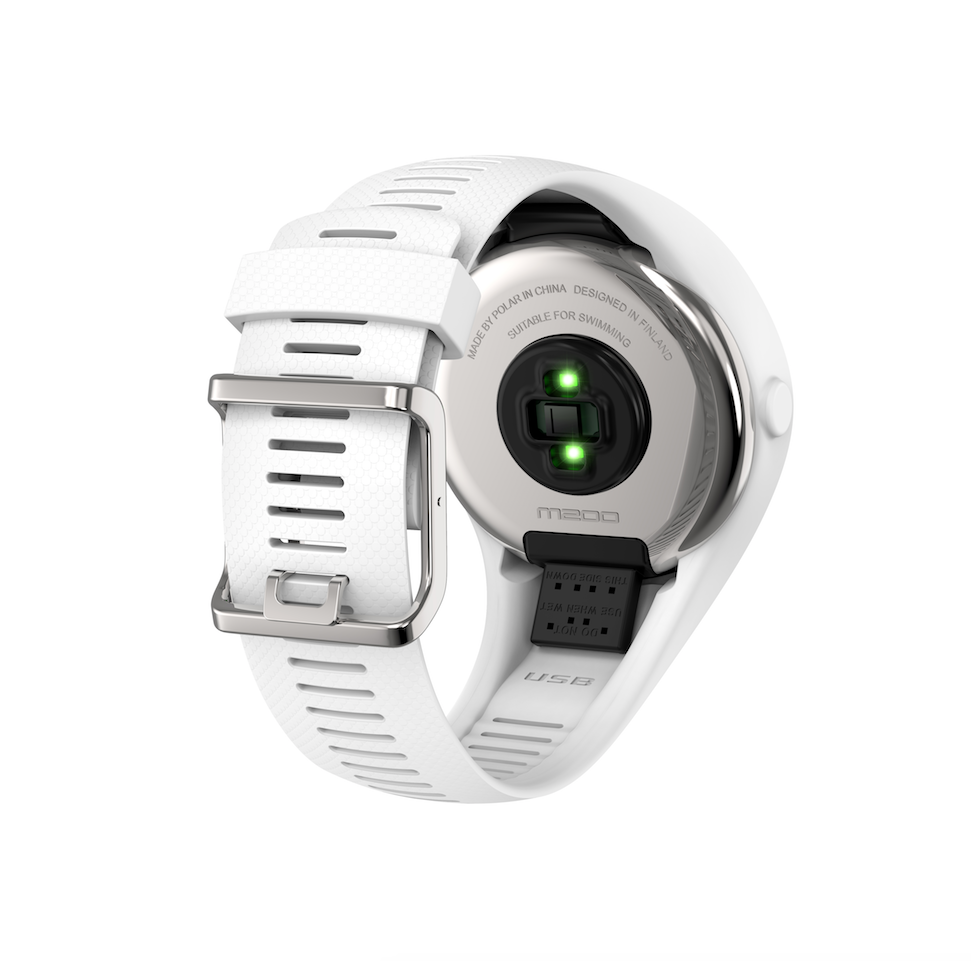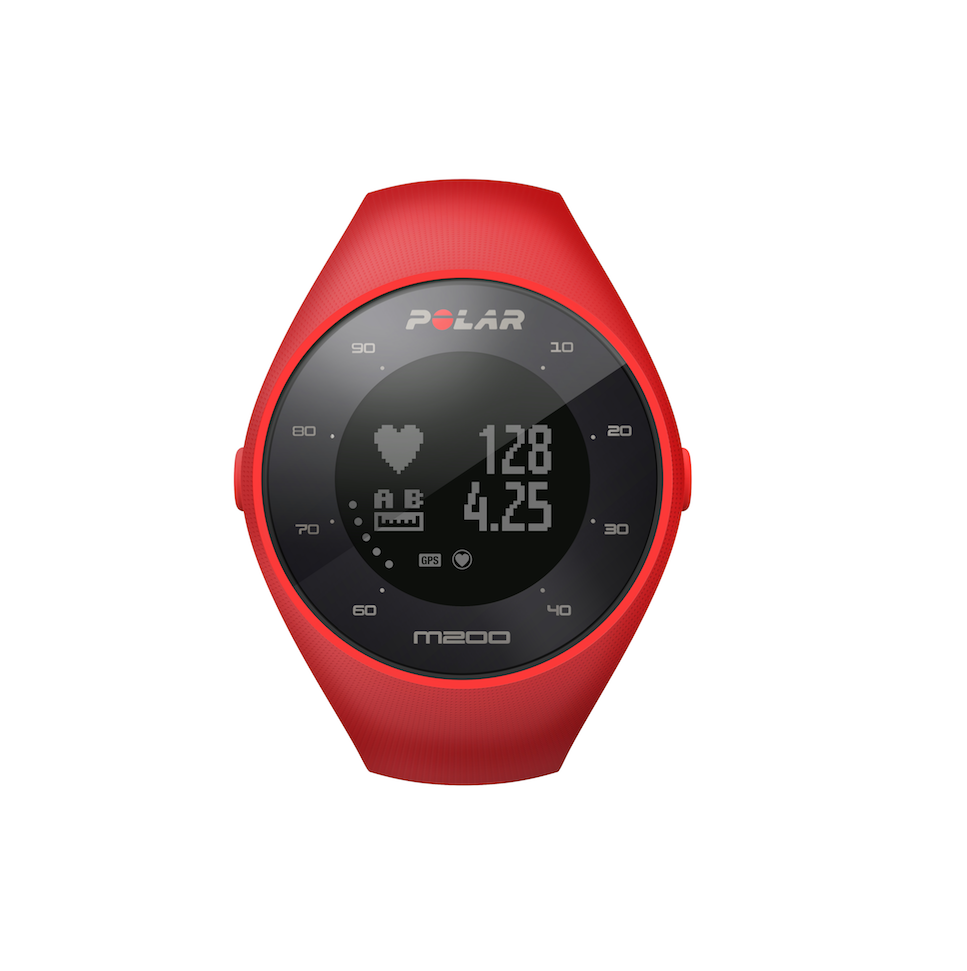Runner Review: The New Polar M200 GPS Watch


Does the wrist-based heart rate tracking work very well? This watch is $30 less ($80 less, with no heart-rate strap included) than the next watch “up” from Polar, the M400—is it worth shelling out the extra cash, or will the M200 meet the needs of runners?
Hopefully by the time you’re done reading this, you’ll have the answers to these questions and more that you may have had about this new sport-watch option from Polar.
M200’s Stand Out Features
There are some things that I really like about this watch. When in training mode, the screen lights up automatically when you turn your wrist to look at the watch face. This is super nice on these days with shortened daylight hours and many runs taking place in low light. In contrast the M400 requires a button push to light up OR can be set with constant backlight, which drains the battery more quickly.
The watch vibrates, beeps, and lights up when you reach an automatic lap (each mile or as set in Polar Flow), showing a quick glimpse at your last mile’s average pace and heart rate. If listening to music, the vibration alerts you to the mile mark whereas a beep alone is easily missed. It also vibrates when a notification comes through from the Polar Flow app so that you don’t miss important notices from your phone. (The M400 lacks the vibration option.) Check here for more information on the basic functioning of the watch, but I’ll focus more on its ease of use and comparison with the Polar M400.
Polar M200 Or M400? How’s The Heart Rate Accuracy?
I spent most of my runs the last two weeks staring at my wrist. I found that the wrist-based heart rate reading sometimes matched the M400’s reading from the chest strap, and sometimes it was off by as much as 5-30 BPM. (NOTE: Wear it just above—not on—the wrist bones to greatly improve accuracy!)
The trouble is, without the other watch, it’s hard to know when the reading is “on” and when it’s over or under the actual beats per minute (when wearing correctly the difference is 0-15 or so BPM). The same was true for the running pace; I found it to respond with dramatic swings to changes in pace, but it would eventually come to match the M400’s reading, or close. The averages are really good on the M200: in both cases, the mile averages were typically within 0-3 BPM for heart rate and 0-8 seconds for the mile times.
Occasionally the mile time would be off by more, but that brings in another difference: the M400 pauses automatically when you do, whereas the M200 requires a button push to pause and another to start again. If you’re stopping to dodge a dog (or take its picture because it looks like yours and you want to show your kids) or for any other interruption, you have to remember to pause the M200. The GPS tracking of distance traveled overestimates a little (.05-.3 miles over 3 miles), when running a route with a lot of turns, but I read that the M400 also had this problem in its beta testing models. This is likely something they’ll resolve in the final product. (The fluctuation in pace that I noticed might also be a beta issue.)

An important thing to be aware of is that the M200 watch band is designed to fit more snuggly than most in order to ensure steady skin contact for heart rate readings. The band worked well in this regard but was also a little tricky to get off: it took me an extra few seconds to get it off every time. Removing (and restoring) the body of the watch from the band for charging or to change band colors, goes smoothly, however. (Additional bands are available for just under $20!)
Another difference is that while the screens of both watches can be customized to show the information that you’re most interested in seeing, the M200 allows for 2 fields per screen and the M400 up to 4. The M400 also tracks running cadence which is an important feature missing in the M200.
Both watches have multiple sport-tracking options, step counts, sleep quality tracking, are waterproof, and have the ability to connect with the Polar Flow app as well as online for customization. The M200 keeps the last 5 workouts in its watch memory with basic facts of each (steps, distance, time, ave heart rate, heart rate max, ave pace, pace max, calories burned) whereas the M400 stores all workouts with more per-mile (or programmed lap) details retained on the watch.

Conclusions
The Polar M200 will meet the needs of a beginner to not-super-hardcore runner with timed distance tracked and very good mile averages for heart rate and pace. It can also be paired with Polar’s H7 heart rate monitor if you decide that you want the more accurate chest-strap readings throughout the workout, but it works well to provide a generally accurate heart rate reading if you don’t want to mess with a chest strap.
The M200 has automatic light-up (in training mode) and vibration notifications, and the M400 does not; however, the M400 numbers are brighter and easier to read. I noticed that battery life goes down quite a bit faster on the M200 when using it with the chest strap—and on the M400 when lighting it up often to compare readings.
So there’s the trade off: M200 is not as bright but auto lights while M400 is brighter but requires the button push. You have a few more options for detailed tracking of workouts in the M400 with cadence being the one that stands out the most to me as I’m trying to keep my steps light and quick, close to 90 steps per foot per minute.
Hopefully now you can decide if the Polar M200 fits what you’re looking for in a sport watch!